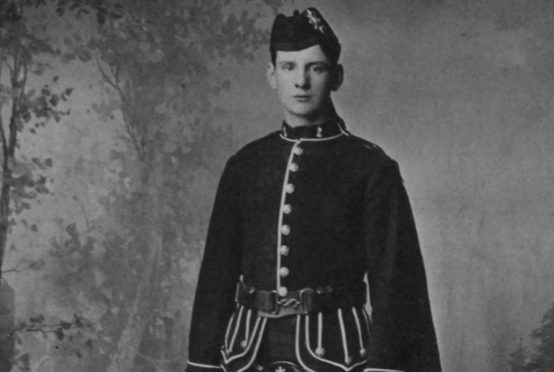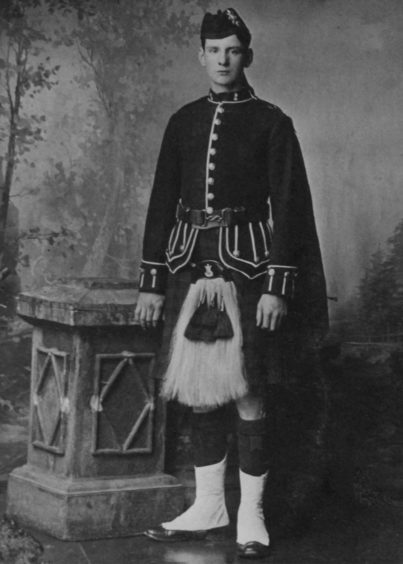As the centenary of Armistice Day 1918 approaches, we will take a look over the next week at real-life accounts of some of the soldiers who gave their all in the First World War, recorded in The Courier’s special commemorative book The Scottish Soldier’s Story.
A tribute to the members of the 8th (Service) Battalion the Black Watch, Royal Highlanders by Major Ronnie Proctor MBE, whose wife Sonia’s grandfather William Reid was in the Black Watch in the First World War.
“The battalion was raised in August 1914 by Lord Sempill of Fintray and first mustered at Albuera Barracks, Aldershot in September 1914. It was part of the 26th (Highland) brigade and 9th Scottish Division.
“Unlike the Territorial battalions recruited from their own local area, the 8th and successive new army battalions were recruited from the regimental area of Angus, Dundee, Fife and Perthshire.
“Farm workers stood side by side with miners, factory workers, shopkeepers and so on throughout the war. Many officers and soldiers were ex-regulars who had re-enlisted soon after war was declared, and the battalion had a firm backbone to steady the young men who had enlisted straight from civilian life.
“Although the battalion quickly reached its established strength, it took some time for uniforms, weapons and equipment to be issued and it was the New Year of 1915 before it was equipped to scale. The men were shipped to France in early May and were soon involved in trench warfare.
“The battalion was engaged in most major battles, the first being the Battle of Loos in September 1915 where Captain the Hon Fergus Bowes-Lyon, the brother of The Queen Mother, was killed at the Hohenzollern Redoubt.
“Trench warfare continued till May 1916 then the battalion took part in the battles of the Somme and Vimy Ridge, first battle of Arras until April 1917 and the second battle of Arras, followed by Passchendaele in March 1918.
“March to May 1918 saw the battalion involved in repulsing the German’s last assault against Britain and her allies on the Western Front.
“When David Lackie Findlay joined in June 1918, the battalion had been in the line in the Hondeghem area and were involved in the attack at Meteren.
“The battalion was heavily involved in the ‘last one hundred days’, the advance to victory. From November 1918 to November 1919 the battalion carried out garrison duties on the Rhine.”
A Soldier’s Story
Pte George Reid of the 1st Black Watch died on Hogmanay, 1914. Wounded at Givenchy, he was one of eight brothers to serve in the conflict, three in The Black Watch.
George, a reservist, returned to the 1st Battalion in Flanders in October 1914, arriving during the British Expeditionary Force’s retreat from the Aisne front.
“They were very quickly put into the lines,” said retired Black Watch Major Ronnie Proctor.
“Pte Reid’s younger brother William (pictured left) was in the Kirriemuir company of the 5th
(Territorial) Battalion Black Watch. He arrived in Le Havre, under age, on November 2, 1914.
“Stewart, the third Black Watch brother, landed in France on October 12 as a sergeant with the 2nd Battalion. Stewart and William met and tried to meet up with George, who fought at the first battle of Ypres and at Givenchy, only to find he had died of his wounds on Hogmanay.”
George’s grave was located by his family recently in a civilian cemetery.
The book Kirriemuir Home Front: World War One – Kirrie Kist’s Soldiering On mentions the Reids of Tillyloss:
“This remarkable family saw eight sons go to war: George, Stewart, James, David, Edwin, Willie, Jack and Geoff.
Some had been in the army, serving abroad, others joined up in answer to the call. Sadly, James was reported lost in action in September 1914. George was killed in action in December.
Buy your copy
First World War – The Scottish Soldier’s Story, is a 150-page compilation of The Courier’s commemorative special First World supplements 1914-1918.
£11.99 with free p&p, available from www.dcthomsonshop.co.uk or call 0800 318 846 (Freephone), quoting CSOST, lines open Mon-Fri 8am-6pm, Sat 9am-5pm.
Also available from the DC Thomson Shop, Albert Square, Dundee DD1 1DD












